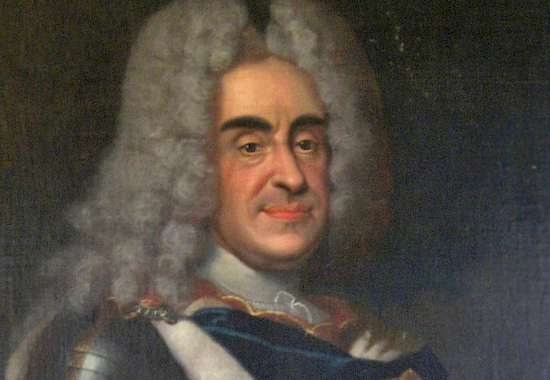August II Grand-Duke of Saxony and King of Poland shaking hands with the King of Prussia in 1728. By 1756, friendship between the two nations was history. – Source: de Silvestre, Dresden, Wikipedia
In 1674, after a divided election, one of the best Polish military commanders, Jan Sobieski, was elevated to the throne. He rebuilt the army, signed a treaty with France, and planned to subjugate Prussia and to strengthen the Polish position in the Baltic region. The magnates, however, were more interested in Ukraine. The Commonwealth returned to an anti-Turkish alliance with the Habsburgs. In 1683 a military expedition led by Jan III Sobieski saved Vienna, which had been besieged by the Ottomans. As a result of this new war with the Turks, Poland recovered its three lost southern provinces in 1699. The king, however, died in 1696, disliked by the nobles, who opposed the royal family’s plans to introduce a hereditary monarchy in Poland.
Not only was the 1697 royal election divided, but for the first time a candidate from a clear minority became king. Most nobles voted for Prince Conti of France, but the Elector of Saxony, Augustus II Friedrich Wettin, supported by a smaller group of nobility, came to Poland with his army and took power. Saxony was blossoming under his government, and he impressed the Polish nobles by converting from Lutheranism to Catholicism. He had ambitious plans and intended to realize them using Poland as a springboard.
Augustus wanted to strengthen royal power in the Commonwealth and to gain Livonia and Courland for his family as a hereditary property. He promised several monarchs various Polish territories in exchange for their support. In 1700 Saxony joined a Russian-Danish anti-Swedish coalition to recover Livonia, taken from Poland by Sweden in the seventeenth century. Formally, the Commonwealth did not participate in the Great Northern War of 1700-1721, but most of its operations took place on Polish territories and devastated them. In 1704 Charles XII of Sweden ejected Augustus from Poland and put the palatine of Poznań, Stanisław Leszczyński, on the Polish throne. In 1706 Augustus, defeated in Saxony, renounced all claims to the throne, but his supporters in the Commonwealth fought together with Russian armies against the Polish supporters of the Swedes and Leszczyński. In 1709 Charles XII suffered a major defeat at Poltava in Ukraine. The Swedes were subsequently driven from the Commonwealth, controlled now by the Russians.
Augustus returned to Poland and tried to ensure his absolute power, which led to a conflict with the nobility. Russia’s tsar, Peter the Great, mediated the dispute, dictated a settlement, and forced both sides to accept it in 1717 during the so-called Silence Sejm, when none of its members dared to utter a word. Augustus renounced his absolutist aspirations and sent his Saxon troops back to Saxony; the army of Lithuania was reduced to 6,000 men and that of Poland to 18,000. The nobility was guaranteed its former privileges, including the liberum veto. Although Russia took Livonia, its troops stayed in the Commonwealth, which now became a Russian protectorate.
During the Great Northern War, Poland’s territories were devastated by the Russian, Swedish, and Saxon armies, which lived off the land. Poor harvests in 1706. 1708 and the Great Plague, which raged until 1711, completed the destruction. Lithuania alone lost about one-third of its population.
In 1733 Augustus II was succeeded on the Polish throne by his son, Augustus III. Russian armies intervened against the candidacies of Portuguese Prince Emanuel and Stanisław Leszczysski, and won the War of Polish Succession. The new king rarely visited the Commonwealth, left it in the hands of his favorites, and subordinated Polish interests to the Wettin dynastic interests. Russia, supported by Prussia, in turn guaranteed what was called the Golden Freedom of the Polish nobility.
